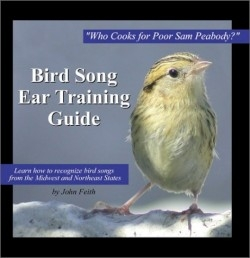Bird Song Ear Training Guide
Who Cooks for Poor Sam Peabody?
More than forty years have passed since environmentalist Rachel Carson warned the world of the threat DDT posed to the bird world in her groundbreaking work Silent Spring. Her warnings were heard, but who is listening now to the calls of those who were threatened? John Feith, a Wisconsin audubonist and audio software designer, is. He has recorded the voices of 189 bird species, primarily in Wisconsin and neighboring Minnesota, but don’t be put off by the Midwestern accents. Most of these songs and cries are from denizens of most of the eastern United States. If not year ’round residents, they are at least familiar travelers during migration.
This CD should be a valuable companion to any field guide for eastern North America. The recordings are divided alphabetically into ninety-five labeled sections, making it easy for the listener to find a specific bird. Each recording is followed by a human voice mnemonically repeating the song, and then a reprise. “Who Cooks for Sam Peabody?” is the deciphered call of the white-throated sparrow. Vocal expressions of the killdeer and black-capped chickadee are quite familiar, but many lesser-known birds require acute listening skills, such as the marsh wren with its reedy rattle. Although many skilled birders can identify birds visually, there are very few who can recognize more than a few dozen birds by song alone. Flycatchers, vireos, and meadowlarks so closely resemble each other that voice is the only true assurance to positive field identification.
A long auto trip could be a good place to introduce this hour-long CD, although it is a little ironic to listen in the comfort of an enclosed vehicle, keeping out what our forefathers heard so clearly. The variety of sounds generated by the feathered world is ear-opening. How many have heard the bloonk-a-doonk of the American bittern or the rhythmic thumping created by the ruffed grouse and never knew whether it was a bird, a plane, or a tractor?
Although the recordings are for the most part very clean with no background noise, they lack the spontaneity and vibrancy of the wild. This is probably attributable to the sameness of volume for each song.
Hearing the shrill “Teacher! Teacher! Teacher!” of the ovenbird daydreams one back to warm summer days, the canoe silently floating in and out of shadows on the Big Two-Hearted River.
Reviewed by
David Zimmerman
Disclosure: This article is not an endorsement, but a review. The publisher of this book provided free copies of the book to have their book reviewed by a professional reviewer. No fee was paid by the publisher for this review. Foreword Reviews only recommends books that we love. Foreword Magazine, Inc. is disclosing this in accordance with the Federal Trade Commission’s 16 CFR, Part 255.

